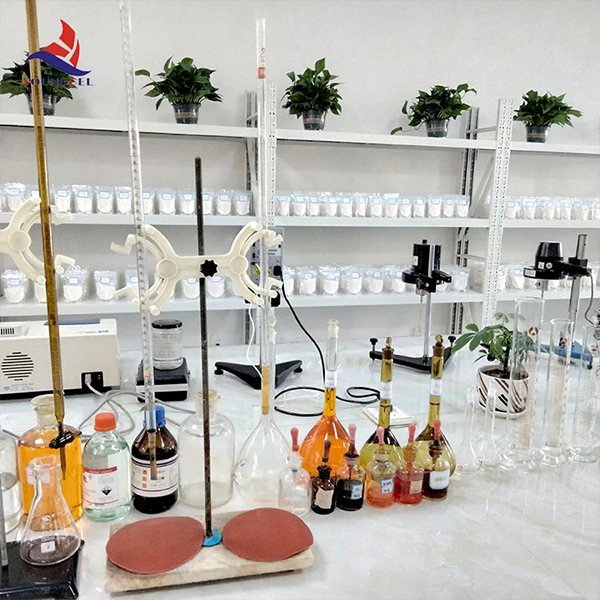Understanding Cellulose Ether A Focus on Hydroxyethyl Methylcellulose (HEMC)
Cellulose ethers are a group of chemically modified natural polymers derived from cellulose, one of the most abundant organic polymers on Earth. Among these, Hydroxyethyl Methylcellulose (HEMC) has gained significant attention across various industries due to its unique properties and versatility. This article delves into the characteristics, applications, and benefits of HEMC while highlighting its importance in modern formulations.
What is Hydroxyethyl Methylcellulose (HEMC)?
HEMC is a water-soluble cellulose ether produced by the alkali treatment of cellulose followed by etherification with methyl and hydroxyethyl groups. This modification facilitates solubility in cold water, making HEMC an ideal candidate for various applications that require thickening, binding, or dispersing agents. The structure of HEMC contributes to its unique rheological properties, providing solutions that can be tailored for different uses, from construction materials to food products.
Characteristics of HEMC
HEMC is characterized by its ability to form viscous solutions at relatively low concentrations. Its properties include
1. Thickening Agent HEMC is widely recognized for its thickening capabilities. In various formulations, even a small amount of HEMC can significantly enhance viscosity, which is crucial in industries such as cosmetics, pharmaceuticals, and food.
2. Stability HEMC is stable over a broad pH range, making it adaptable to different environments. This stability is particularly valuable in products exposed to varying conditions, such as personal care items and construction materials.
3. Film-Forming Properties The ability to form thin, continuous films makes HEMC useful in coatings, adhesives, and linoleum, where a protective layer is essential.
4. Water Retention In formulations such as mortars and plasters, HEMC helps retain water, allowing for better workability and extended open time during application.
5. Biodegradability Being derived from cellulose, HEMC is considered more environmentally friendly compared to synthetic alternatives, appealing to manufacturers focused on sustainability.
Applications of HEMC
HEMC's versatility makes it suitable for a myriad of applications across different sectors
cellulose ether hemc

1. Construction In the construction industry, HEMC is widely used in tile adhesives, joint compounds, and stucco. Its thickening and water retention properties improve adhesion and workability.
2. Cosmetics HEMC is frequently incorporated into lotions, creams, and gels. Its film-forming ability provides a smooth texture, enhances moisture retention, and maintains product stability.
3. Pharmaceuticals In drug formulations, HEMC serves as a binder and thickening agent, improving the viscosity of suspensions and ensuring uniform distribution of active ingredients.
4. Food Industry HEMC is utilized as a thickener and stabilizer in various food products, including sauces, dressings, and frozen foods. Its ability to enhance texture without altering flavor is highly valued.
5. Paints and Coatings HEMC is added to paint formulations to enhance viscosity and ensure even application, while also improving water resistance and preventing sedimentation.
Benefits of Using HEMC
The incorporation of HEMC into formulations confers multiple advantages
- Enhanced Performance Products containing HEMC typically demonstrate improved performance characteristics such as viscosity, stability, and adherence. - Cost-Efficiency Due to its efficacy at low concentrations, HEMC can be a cost-effective solution for various industries.
- Versatile Usage The adaptability of HEMC across different pH levels and temperatures makes it an invaluable ingredient in diverse formulations.
- Sustainability As a cellulose-derived product, HEMC aligns with the growing demand for environmentally responsible materials, beneficial for brands aiming to project an eco-friendly image.
Conclusion
Hydroxyethyl Methylcellulose is a remarkable cellulose ether with extensive applications and remarkable benefits. Its versatile properties make it an indispensable ingredient in construction, cosmetics, pharmaceuticals, food, and more. As industries continue to prioritize sustainability and performance, HEMC will undoubtedly play a crucial role in meeting these evolving demands, standing out as a quintessential ingredient in modern formulations.
-
The Application and Significance of Construction RdpNewsMay.19,2025
-
Industrial Grade HpmcNewsMay.19,2025
-
Building Coating Adhesive Building Coating Adhesive HpmcNewsMay.19,2025
-
Application Of Hpmc For Detergent For Detergent In DetergentsNewsMay.19,2025
-
Application Of Hpmc Cellulose In Cement-Based MaterialsNewsMay.19,2025
-
Application Of High Quality Hpmc For Construction In The Field Of ConstructionNewsMay.19,2025




